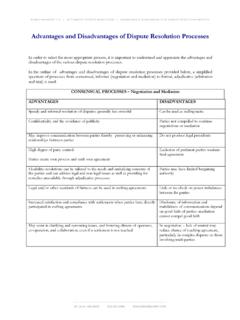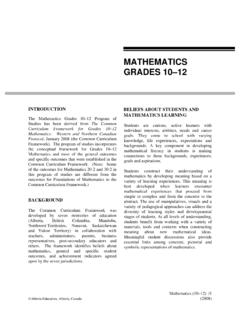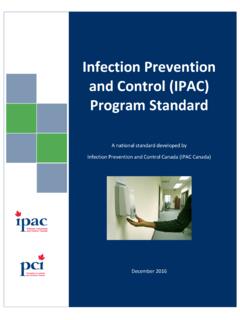Transcription of Guide to Litigation in Canada - Blaney
1 Guide to Litigation in Canada 1 Guide to Litigation in CanadaCONTENTSI ntroduction: Litigating in 3 Litigation in Each Province British New Newfoundland and Nova Prince Edward 28481113161920222426 Guide to Litigation in Canada 3 introduction : LITIGATING IN Canada Canada has a population of 35 million people which is less than the population of California. It is approximately million square miles which makes it the second largest country in the world. It is divided into ten provinces and three territories. Each province and territory has its own government. The capital of Canada is the City of Ottawa where the federal House of Commons and Senate create legislation which applies to the entire country. Each province has its own capital where their legislatures exist and pass laws for their particular is a constitutional democracy however, its constitution is made up of a number of statutes, orders-in-council and judicial decisions which interpret these documents.
2 One of the most significant is The Constitution Act, 1867. This act divides different powers between the federal and provincial governments. The Constitution Act, 1867 provides the provinces with the power to administer justice in their own provinces. As such, each province will have its own unique court system and administration to carry out the laws of the land. It is because of these procedural differences that lawyers will typically practice within their own province. While the courts are operated by the province, the judges in civil courts are appointed by the federal government. Guide to Litigation in Canada 4 The two most populous centres in Alberta are Edmonton, the capital of the province, and Calgary which is seen as the corporate epicentre of the province. Both cities are very close in population both hovering around the million mark. There are two levels of court in Alberta dealing with civil Litigation : The Court of Queen s Bench and Provincial Court Civil Division.
3 Appeals from Provincial Court are to Queen s Bench and appeals from Queen s Bench are to the Alberta Court of Court of Queen s BenchStep One: The PleadingsA civil action for an amount in excess of $50,000 is commenced in the Court of Queen s Bench by way of Statement of Claim within 2 years of a date of loss. The Statement of Claim delineates the nature of the claim, the facts establishing the claim, the allegations against the defendant respecting liability to the plaintiff and the amounts being sought for all heads of damage being claimed. Once filed, the plaintiff has 12 months to serve it on the defendant. Once the defendant is served he has 20 days to file a Statement of Defence or a Demand of Notice if he is served within Alberta; 1 month if he is served outside Alberta, but within Canada ; and 2 months if served outside Canada . If the defendant has a counterclaim against the plaintiff it is filed concurrently with the Statement of Defence.
4 A defendant by counterclaim has the same time requirements to file a Statement of Defence to Counterclaim. If there is a co-defendant from whom a defendant is seeking contribution and indemnity, then the defendant has 20 days to file and serve a Notice of Claim Against Co-Defendant. If there is another party the defendant seeks to add to the Litigation , a Third Party Claim must be filed and served within 6 months of the Statement of Defence is filed. The Statement of Defence to Third Party Claim has the same timelines for filing as a Statement of Defence. A plaintiff may file a Reply to a Statement of Defence and has 10 days to do so after being served with the Statement of Defence. Similarly, the plaintiff may file a Reply to Third Party Statement of Defence within 10 days of being served with the Statement of Defence to Third Party Claim. All of these documents are collectively referred to as the 4 months of filing the Statement of Defence, the parties must determine if the case is a standard case or a complex case.
5 If the parties do not agree within this time frame and the court does not otherwise order, the case is deemed to be a standard case. If there are delays, one party can serve on another a Litigation Plan setting out timelines and if no agreement is reached an application may be made for an Order setting timelines. For a complex case, the parties must, within 4 months of determining the case is complex, agree to a Complex Litigation Plan. Once the plan is agreed, the plaintiff must file and serve it on all IN ALBERTAC algary MacLeod Venturo Lund Woodske to Litigation in Canada 5 Step Two: DisclosureWithin 3 months from being served with the Statement of Defence a plaintiff must serve an Affidavit of Records. Once served with the Affidavit of Records of the plaintiff, the defendant has 2 months to serve his Affidavit of Records. A third party has 3 months from being added to an action to serve an Affidavit of Records.
6 An Affidavit of Records consists of 3 Schedules. Schedule 1 is a list of documents which are not privileged. Schedule 2 is a list of documents which are privileged. Schedule 3 is a list of documents which may be relevant, but are no longer within the control of the party swearing the Affidavit of Records. On application the Court may order a record not previously produced be produced if a record has been improperly omitted or if it has been improperly claimed as documents are exchanged the parties will proceed to Questioning. During this process all parties adverse in interest have a right to examine the opposing party(s) to discover all of the facts and evidence the other party has which is not disclosed in the records. The right to Question extends to questions about the records as well. During this process a party being Questioned may be asked to search for additional records or information not previously disclosed.
7 These requests are called Undertakings. The Undertakings given must be answered within a reasonable period of time after Questioning is completed. The party giving the Undertaking may be required to re-attend for Questioning on the Undertakings Three: SettlementThe Rules of Court in Alberta do not provide for mandatory ADR. Still, ADR is used options for ADR in Alberta include Arbitration (binding or non-binding), Mediation (binding or non-binding), or Judicial Dispute Resolution (JDR) (binding or non-binding). The JDR is a more formal mediation before a Justice of the Court of Queen s Bench. The parties are required to submit written briefs of their respective positions for the Justice in advance followed by oral submissions during the course of the JDR. The process is informal , typically in a boardroom at the Courthouse. No documents are filed with the Court during this process and the written submissions are not kept on the Court file.
8 If the matter does not settle during the JDR process, the Justice makes a note on the file a JDR happened, but failed and the JDR Justice is precluded from hearing the FourIf parties decide Trial is necessary they must file a Form 37 with the Court advising they are ready for Trial. Form 37 outlines for the Court how long of trial, how many witnesses, administrative requirements as well as which Justices are precluded from hearing the matter due to conflicts. A party may also bring an application in Form 38 to request the Court order a Trial be set. Three months prior to the Trial date the parties must file a Form 39 confirming the parties are ready to proceed to Trial and modify any information respecting witnesses or needs during the Trial. Failure to confirm readiness for Trial will result in the Trial being canceled. Once the date is confirmed, the cost for setting the matter for Trial is $ plus $ per day of Trial exceeding 5 Applications may be made at any time from the commencement of the matter through to prior to making application to the Court for a Trial date.
9 On application, the Court will determine whether the matter is appropriate to be heard before a jury or not. A Jury consists of six members of the public. A decision need not be unanimous it can be rendered with an agreement of five out of six jurors agreeing. It should be noted few civil cases are tried by jury and the Court is reluctant to Order jury are heard by the Alberta Court of Appeal which sits in both Edmonton and to Litigation in Canada 6 The Provincial Court Civil DivisionIn Alberta there are no formal Rules of Court governing Litigation . It operates pursuant to the Provincial Court Act and the Provincial Court Civil Division Regulation. Jurisdiction for the Provincial Court Civil Division is $50, or less and they have authority to hear any civil Litigation matter with a few exceptions. Step One: The PleadingsA civil action is commenced in the Provincial Court Civil Division by way of Civil Claim in the prescribed form within 2 years of a date of loss.
10 Once a claim is filed, the plaintiff has 12 months to serve it on the defendant. If service is not completed within that time frame, it is no longer valid. Once the defendant is served he has 20 days to file a Dispute Note in the prescribed form if he is served within Alberta and 30 days if he is served outside Alberta. If the defendant has a counterclaim against the plaintiff it is filed concurrently with the Dispute Note. A defendant by counterclaim has the same time requirements to file a Dispute Note to Counterclaim. Service of the Dispute Note is deemed service of the Counterclaim when filed together. There is no specific direction respecting claims for contribution and indemnity between defendants; however, the usual practice is to follow the Court of Queen s Bench Rules in this regard allowing the defendant 20 days to file and serve a Notice of Claim Against Co-Defendant.










